module 5 Energy, Flows, and Feedbacks
Energy flows within and among systems. Plants and other photosynthetic organisms such as the algae in Mono Lake absorb solar energy and use it in photosynthesis to convert carbon dioxide and water into sugars they need to survive, grow, and reproduce. Animals such as the brine shrimp in Mono Lake eat those plants and the energy is transferred. When migrating gulls use Mono Lake as a stopover, they consume the brine shrimp and transfer the energy and nutrients elsewhere. Some transfers occur more effectively than others. Some transfers occur within a given system while others, like those of migrating gulls, result in transfers of material and energy to another system.
Learning Objectives
After reading this module you should be able to
distinguish among various forms of energy and understand how they are measured.
discuss the first and second laws of thermodynamics and explain how they influence environmental systems.
explain how scientists keep track of energy and matter inputs, outputs, and changes to environmental systems.
Energy is a fundamental component of environmental systems
Energy The ability to do work or transfer heat.
Earth’s systems cannot function, and organisms cannot survive, without energy. Energy is the ability to do work, or transfer heat. Water flowing into a lake has energy because it moves and can move other objects in its path.
All living systems absorb energy from their surroundings and use it to organize and reorganize molecules within their cells and to power movement. The sugars in plants are also an important energy source for many animals. Humans, like other animals, absorb the energy they need for cellular respiration from food. This provides the energy for our daily activities, from waking to sleeping to walking, and everything in between. Constructed human systems also utilize energy. If you took mass transportation or an automobile to get to school, you most likely utilized fossil fuel energy that was converted to the energy of motion of your vehicle.
Joule The amount of energy used when a 1-
The basic unit of energy in the metric system is the joule ( J). A joule is the amount of energy used when a 1-
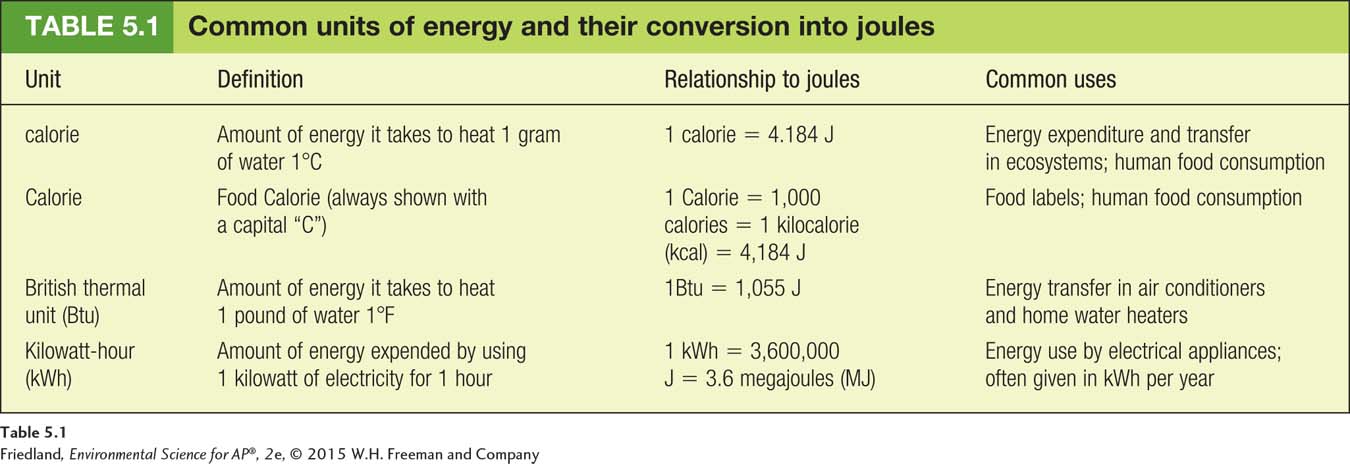
Power The rate at which work is done.
Although we often use the words “energy” and “power” interchangeably, they are not the same thing. We have seen that energy is the ability to do work. Power is the rate at which work is done:
energy = power × time
power = energy ÷ time
When we talk about generating electricity, we often hear about kilowatts and kilowatt-
Forms of Energy
Energy exists in different forms and can be converted from one form to another. Potential energy, kinetic energy, light energy, chemical energy, and sound energy are all important energy forms in the environmental sciences.
Electromagnetic Radiation
Electromagnetic radiation A form of energy emitted by the Sun that includes, but is not limited to, visible light, ultraviolet light, and infrared energy.
Ultimately, most energy on Earth derives from the Sun. The Sun emits electromagnetic radiation, a form of energy that includes, but is not limited to, visible light, ultraviolet light, and infrared energy, which we perceive as heat. The scale at the top of FIGURE 5.1 shows these and other types of electromagnetic radiation.
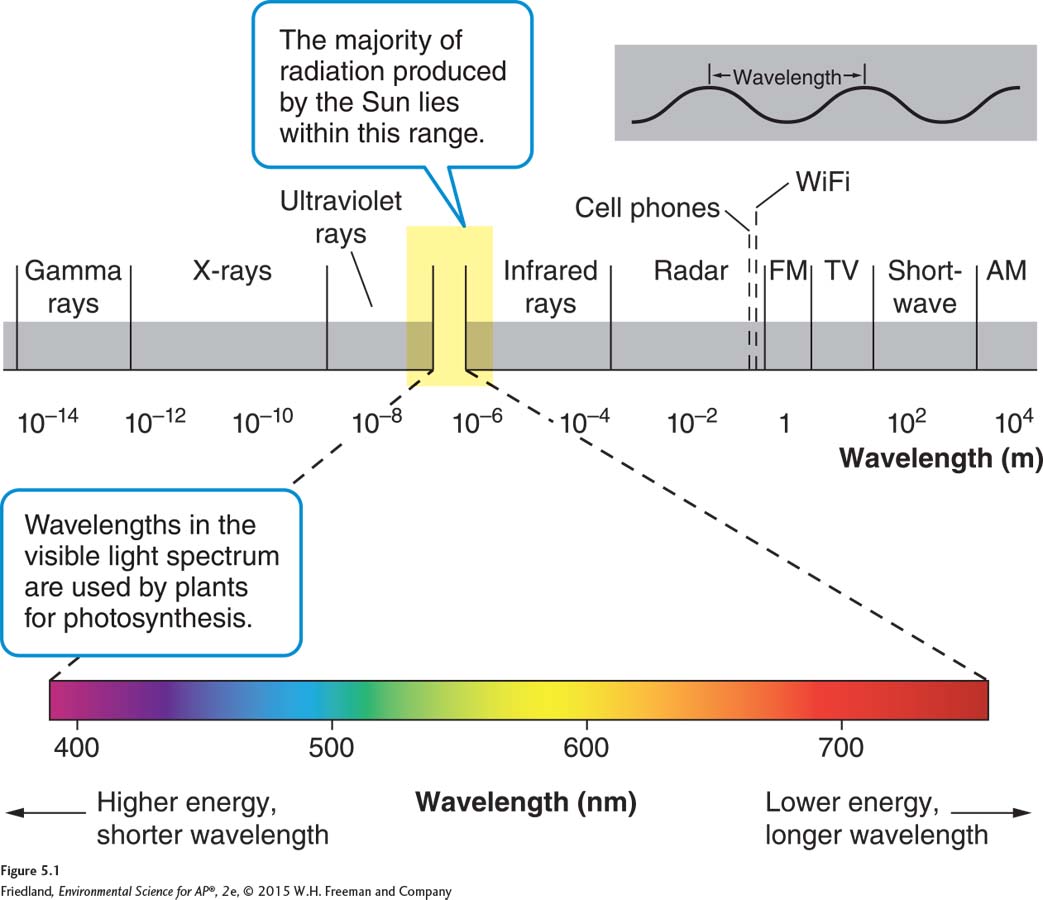
Photon A massless packet of energy that carries electromagnetic radiation at the speed of light.
Electromagnetic radiation is carried by photons, massless packets of energy that travel at the speed of light and can move even through the vacuum of space. The amount of energy contained in a photon depends on its wavelength—
Potential Energy
Potential energy Stored energy that has not been released.
Chemical energy Potential energy stored in chemical bonds.
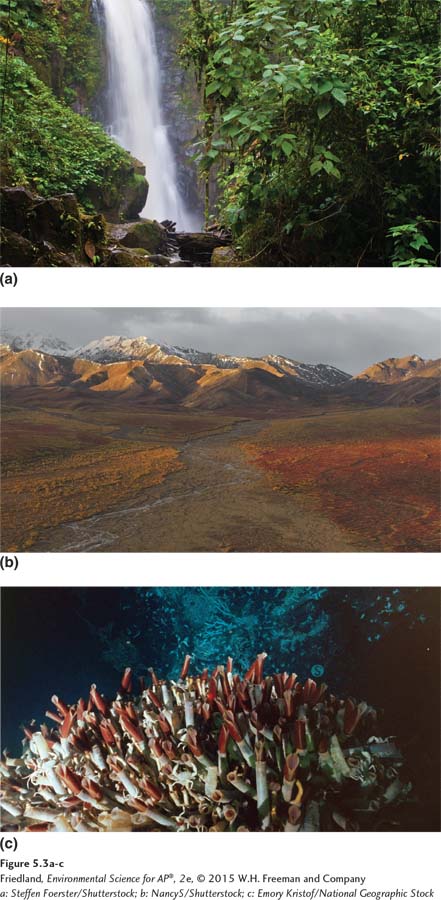
Many stationary objects possess a large amount of potential energy—energy that is stored but has not yet been released. For example, water impounded behind a dam contains a great deal of potential energy. Potential energy stored in chemical bonds is known as chemical energy. The energy in food is a familiar example. By breaking down the high-
Kinetic Energy
Kinetic energy The energy of motion.
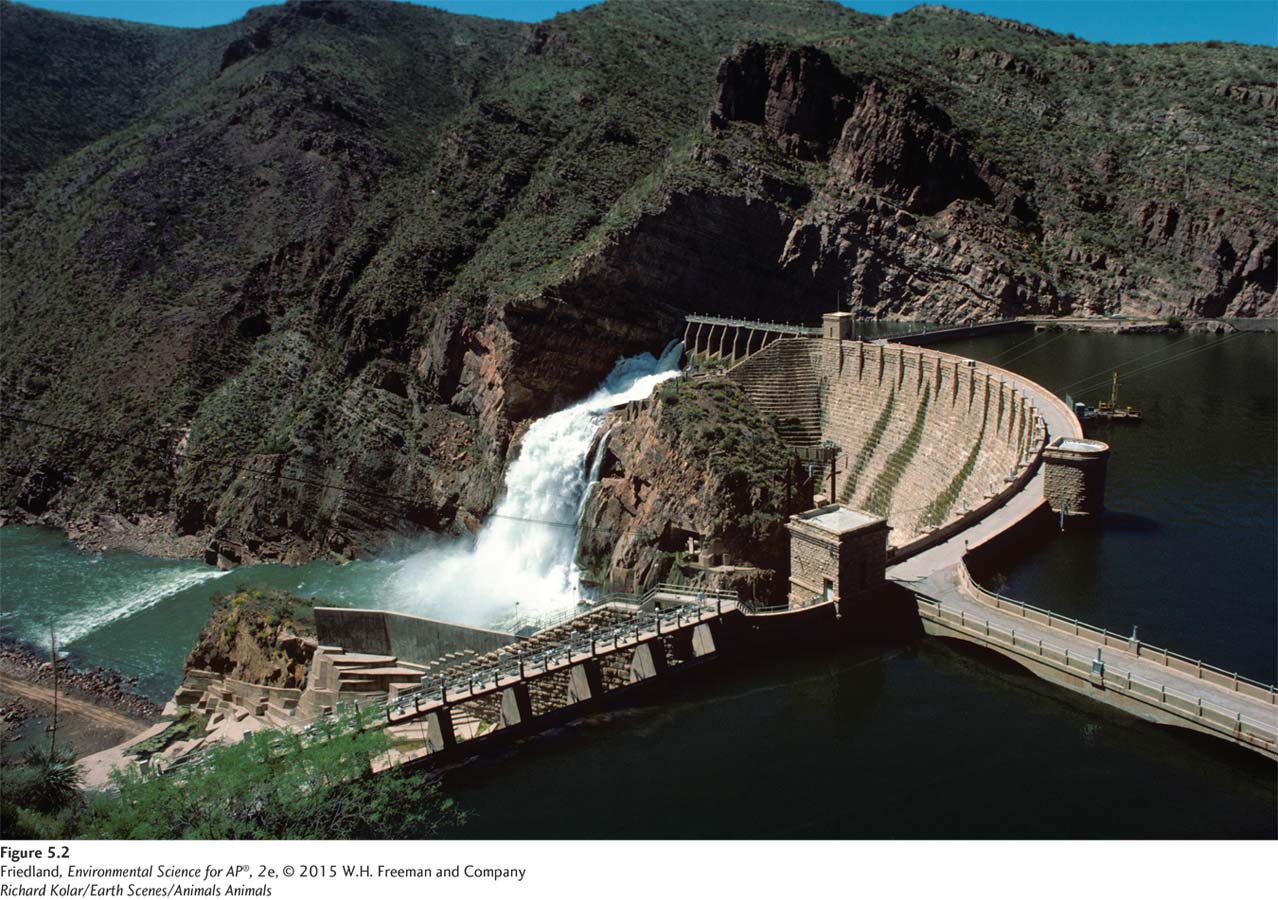
We noted that water impounded behind a dam contains a great deal of potential energy. When the water is released and flows downstream, that potential energy becomes kinetic energy, the energy of motion (FIGURE 5.2). The kinetic energy of moving water can be captured at a dam and transferred to a turbine and generator, and ultimately to the energy in electricity. Can you think of other common examples of kinetic energy? A car moving down the street, a flying honeybee, and a football traveling through the air all have kinetic energy. Sound also has kinetic energy because it travels in waves through the coordinated motion of atoms. Systems can contain potential energy, kinetic energy, or some of each.
Temperature The measure of the average kinetic energy of a substance.
All matter, even the frozen water in the world’s ice caps, contains some energy. When we say that energy moves matter, we mean that it is moving the molecules within a substance. The measure of the average kinetic energy of a substance is its temperature.
Changes in temperature—
Energy Conversions
Individual organisms rely on a continuous input of energy in order to survive, grow, and reproduce. But interactions beyond the organism can also be seen as a process of converting energy into organized structures such as leaves and branches. Consider a forest ecosystem. Trees absorb water through their roots and carbon dioxide through their leaves. By combining these compounds in the presence of sunlight, they convert water and carbon dioxide into sugars that will provide them with the energy they need. But then a deer grazes on tree leaves, and later a mountain lion eats the deer. At each step, energy is converted by organisms into work.
The form and amount of energy available in an environment determines what kinds of organisms can live there. Plants thrive in tropical rainforests where there is plenty of sunlight and water. Many food crops, not surprisingly, can be planted and grown in temperate climates that have a moderate amount of sunlight. Life is much more sparse at high latitudes, toward the North and South Poles, where less solar energy is available to organisms. These landscapes are populated mainly by small plants and shrubs, insects, and migrating animals. Plants cannot live at all on the deep ocean floor, where no solar energy penetrates. The animals that live there, such as eels, anglerfish, and squid, get their energy by feeding on dead organisms that sink from above. Chemical energy, in the form of sulfides emitted from deep-
The laws of thermodynamics describe how energy behaves
In Chapter 1 we saw that some theories have no known exceptions. Two theories concerning energy fall in this category. The laws of thermodynamics are among the most significant principles in all of science.
First Law of Thermodynamics
First law of thermodynamics A physical law which states that energy can neither be created nor destroyed but can change from one form to another.
Impounded water behind a dam is quiet, still, and unmoving. It doesn’t seem like it contains a lot of energy. But in fact that water contains a great deal of potential energy. If you release that water by opening a gate in the dam, the water rushes out. The potential energy of the impounded water becomes the kinetic energy of the water rushing through the gates of the dam. This is an illustration of the first law of thermodynamics, which states that energy is neither created nor destroyed but it can change from one form to another.
The first law of thermodynamics dictates that you can’t get something from nothing. When an organism needs biologically usable energy, it must convert it from an energy source such as the Sun or food. The potential energy contained in firewood never goes away but is transformed into heat energy permeating a room when the wood is burned in a fireplace. Sometimes it may be difficult to identify where the energy is going, but it is always conserved.
Look at FIGURE 5.4, which uses a car to show the first law in action through a series of energy conversions. Think of the car, including its fuel tank, as a system. The potential energy of the fuel (gasoline) is converted into kinetic energy when the battery supplies a spark in the presence of gasoline and air. The gasoline combusts, and the resulting gases expand, pushing the pistons in the engine—
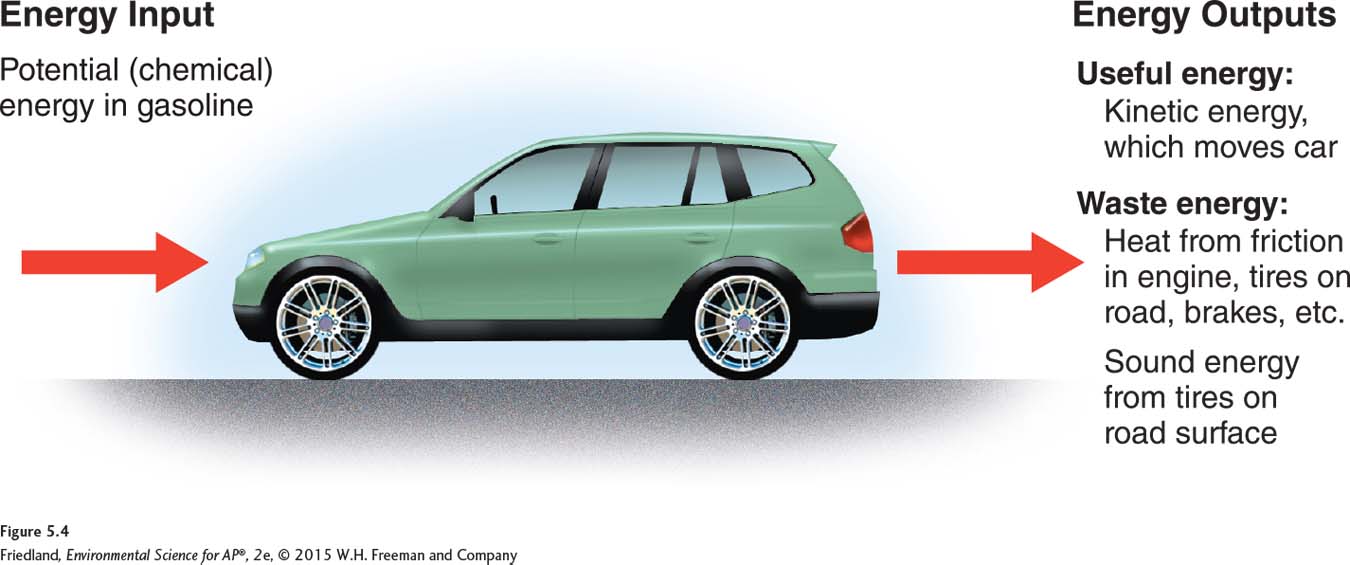
Second Law of Thermodynamics
Second law of thermodynamics The physical law stating that when energy is transformed, the quantity of energy remains the same, but its ability to do work diminishes.
We have seen how the potential energy of gasoline is transformed into the kinetic energy of moving pistons in a car engine. But as FIGURE 5.4 shows, some of that energy is converted into a less usable form—
Energy Efficiency
Energy efficiency The ratio of the amount of energy expended in the form you want to the total amount of energy that is introduced into the system.
To quantify the second law of thermodynamics, we use the concept of energy efficiency. Energy efficiency is the ratio of the amount of energy expended in the desired form to the total amount of energy that is introduced into the system. Two machines or engines that perform the same amount of work, but use different amounts of energy to do that work, have different energy efficiencies. Consider the difference between modern woodstoves and traditional open fireplaces. A woodstove that is 70 percent efficient might use 2 kg of wood to heat a room to a comfortable 20°C (68°F), whereas a fireplace that is 10 percent efficient would require 14 kg of wood to achieve the same temperature—

We can also calculate the energy efficiency of transforming one form of energy into other forms of energy. Let’s consider what happens when we convert the chemical energy of coal into the electricity that provides light from a reading lamp and the heat that the lamp releases. FIGURE 5.6 shows the process.

A modern coal-
In the electrical transmission lines between the power plant and the house, 10 percent of the electrical energy from the plant is lost as heat and sound, so the transport of energy away from the plant is about 90 percent efficient. We know that the conversion of electrical energy into light in an incandescent bulb is 5 percent efficient; again, the rest of the energy is lost as heat. From beginning to end, we can calculate the energy efficiency of converting coal into incandescent lighting by multiplying all the individual efficiencies:
Calculating energy efficiency:
| Coal to electricity | × | transport of electricity | × | light bulb efficiency | = | overall efficiency |
| 0.35 | × | 0.90 | × | 0.05 | = | 0.016 (1.6% efficiency) |
Energy Quality
Energy quality The ease with which an energy source can be used for work.
Most of us have an intuitive sense about the relative effectiveness of various energy sources. For example, we realize that gasoline is a more useful source of energy than paper. This difference is a function of each material’s energy quality, the ease with which an energy source can be used for work. A high-
Gasoline, for example, is a high-
Entropy
Entropy Randomness in a system.
The second law of thermodynamics also tells us that all systems move toward randomness rather than toward order. This randomness in a system, called entropy, is always increasing unless new energy from outside the system is added to create order.
Think of your bedroom as a system. At the start of the week, your books may be in the bookcase, your clothes may be in the dresser, and your shoes may be lined up in a row in the closet. But what happens if, as the week goes on, you don’t expend energy to put your things away (FIGURE 5.7)? Unfortunately, your books will not spontaneously line up in the bookcase, your clothes will not fall folded into the dresser, and your shoes will not pair up and arrange themselves in the closet. Unless you bring energy into the system to put things in order, your room will slowly become more and more disorganized.
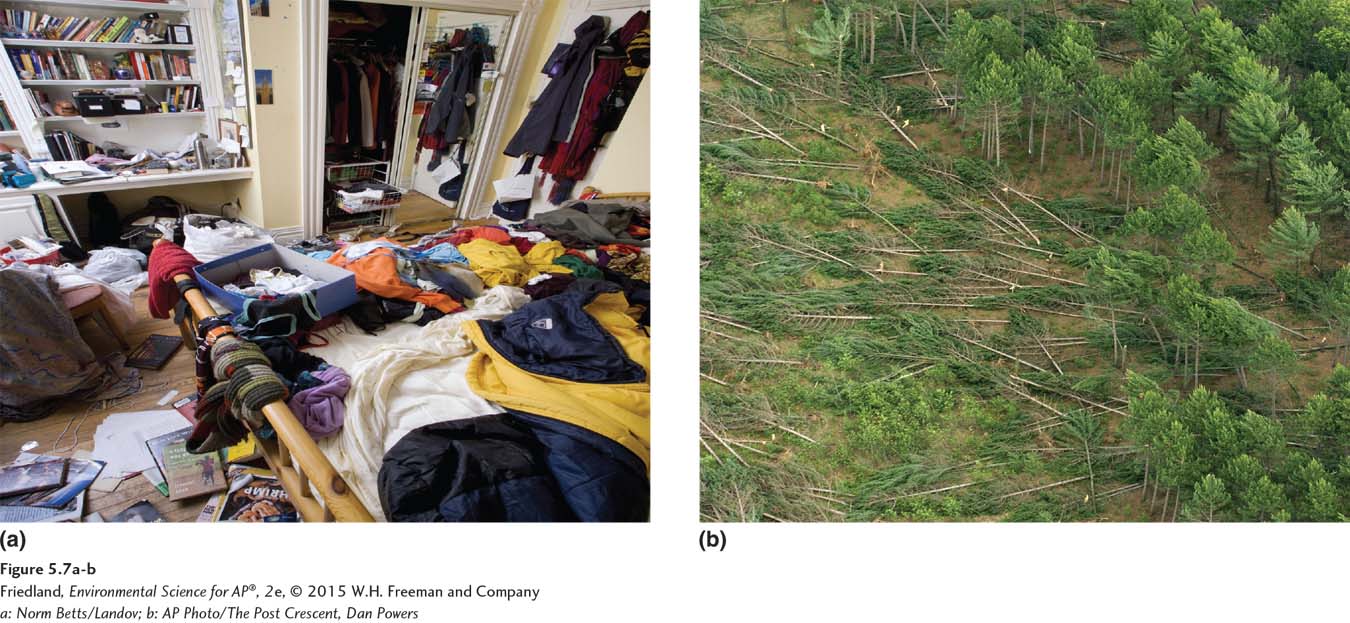
The energy you use to pick up your room comes from the energy stored in food. Food is a relatively high-
Another example of the second law can be found in the observation that energy always flows from hot to cold. A pot of water will never boil without an input of energy, but hot water left alone will gradually cool as its energy dissipates into the surrounding air. This application of the second law is important in many of the global circulation patterns that are powered by the energy of the Sun.
Matter and energy flow in the environment
Why do environmental scientists study whole systems rather than focusing on the individual plants, animals, or substances within a system? Imagine taking apart your cell phone and trying to understand how it works simply by focusing on the microphone. You wouldn’t get very far. Similarly, it is important for environmental scientists to look at the whole picture and not just the individual parts of a system in order to understand how that system works. With a working knowledge of how a system functions, we can predict how changes to any part of the system—
Studying systems allows scientists to think about how matter and energy flow in the environment. In this way, researchers can learn about the complex relationships between organisms and the environment. In this section we will explore system dynamics and changes in systems across space and over time. In each case we will focus on how energy and matter flow in the environment.
System Dynamics
As we suggested at the beginning of this chapter, the Mono Lake ecosystem changes over time. Some years there is more algae growing in the lake and that feeds more brine shrimp. Some years fewer migrating gulls stop over and feed, removing less matter and energy from the system, while in other years, more gulls stop over. These changing parameters describe the system dynamics of the Mono Lake ecosystem. There are a number of terms used to describe systems and we will present some of them in this section.
Open and Closed Systems
Open system A system in which exchanges of matter or energy occur across system boundaries.
Systems can be either open or closed. In an open system, exchanges of matter or energy occur across system boundaries. Most systems are open. Even at remote Mono Lake, water flows in and birds fly to and from the lake. The ocean is also an open system. Energy from the Sun enters the ocean, warming the waters and providing energy to plants and algae. Energy and matter are transferred from the ocean to the atmosphere as energy from the Sun evaporates the water, giving rise to meteorological events such as tropical storms in which clouds form and send rain back to the ocean surface. Matter, such as sediment and nutrients, enters the ocean from rivers and streams and leaves it through geologic cycles and other processes.
Closed system A system in which matter and energy exchanges do not occur across boundaries.
In a closed system, matter and energy exchanges do not occur across system boundaries. Closed systems are less common than open systems. Some underground cave systems are almost completely closed systems.
As FIGURE 5.8 shows, Earth is an open system with respect to energy. Solar radiation enters Earth’s atmosphere, and heat and reflected light leave it. But because of its gravitational field, Earth is essentially a closed system with respect to matter. Only an insignificant amount of material enters or leaves the Earth system. All important material exchanges occur within the system.
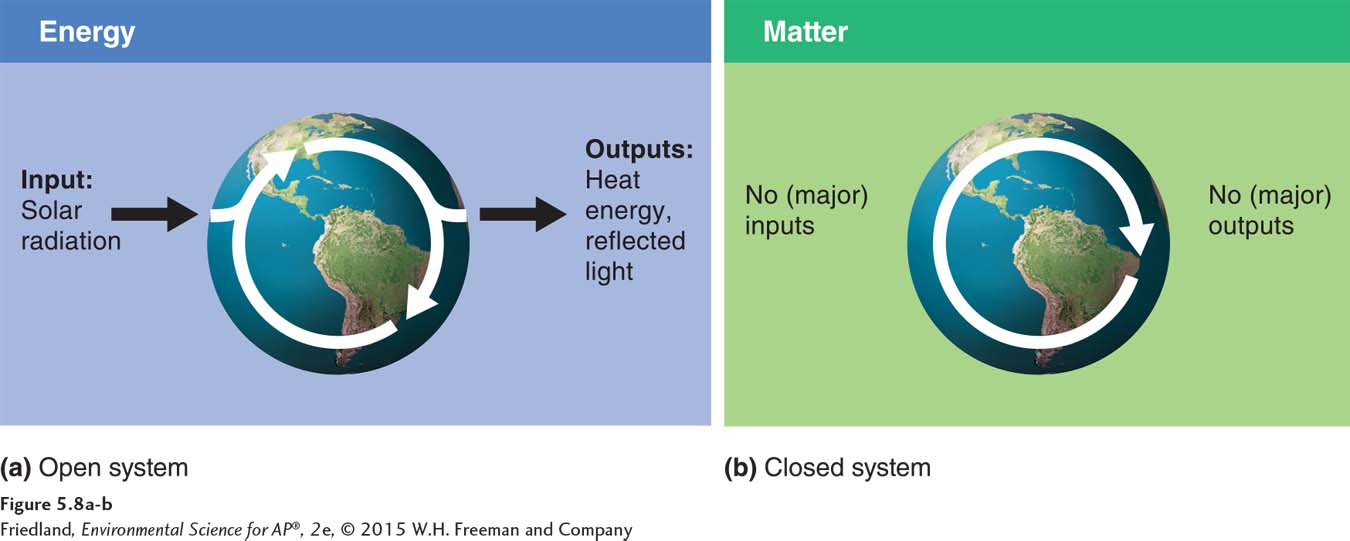
Inputs and Outputs
Input An addition to a system.
Output A loss from a system.
Systems analysis An analysis to determine inputs, outputs, and changes in a system under various conditions.
By now you have seen numerous examples of both inputs, which are additions to a given system, and outputs, which are losses from the system. People who study systems often conduct a systems analysis, in which they determine inputs, outputs, and changes in the system under various conditions. For instance, researchers studying Mono Lake might quantify the inputs to that system—
Steady States
Steady state A state in which inputs equal outputs, so that the system is not changing over time.

In any given period at Mono Lake, the same amount of water that enters the lake eventually evaporates. In many cases, the most important aspect of conducting a systems analysis is determining whether your system is in steady state—that is, whether inputs equal outputs, so that the system is not changing over time. This information is particularly useful in the study of environmental science. For example, it allows us to know whether the amount of a valuable resource or a harmful pollutant is increasing, decreasing, or staying the same.
The first step in determining whether a system is in steady state is to measure the amount of matter and energy within it. If the scale of the system allows, we can perform these measurements directly. Consider the leaky bucket shown in FIGURE 5.9. We can measure the amount of water going into the bucket and the amount of water flowing out through the holes in the bottom. However, some properties of systems, such as the volume of a lake or the size of an insect population, are difficult to measure directly, so we must calculate or estimate the amount of energy or matter stored in the system. We can then use this information to determine the inputs to and outputs from the system to determine whether it is in steady state.
Many aspects of natural systems, such as the water vapor in the global atmosphere, have been in steady state for at least as long as we have been studying them. The amount of water that enters the atmosphere by evaporation from oceans, rivers, and lakes is roughly equal to the amount that falls from the atmosphere as precipitation. Until recently, the oceans have also been in steady state: The amount of water that enters from rivers and streams has been roughly equal to the amount that evaporates into the air. One concern about the effects of global climate change is that some global systems, such as the system that includes water balance in the oceans and atmosphere, may no longer be in steady state.
It’s interesting to note that one part of a system can be in steady state while another part is not. Before the Los Angeles Aqueduct was built, the Mono Lake system was in steady state with respect to water but not with respect to salt. The inflow of water equaled the rate of water evaporation but salt was slowly accumulating, as it does in all terminal lakes.
Feedbacks
Most natural systems are in steady state. Why? A natural system can respond to changes in its inputs and outputs. For example, during a period of drought, evaporation from a lake will be greater than combined precipitation and stream water flowing into the lake. Therefore, the lake will begin to dry up. Soon there will be less surface water available for evaporation, so the evaporation rate will continue to fall until it matches the new, lower precipitation rate. When this happens, the system returns to steady state, and the lake stops shrinking.
Of course, the opposite is also true. In very wet periods, the size of the lake will grow, and evaporation from the expanded surface area will continue to increase until the system returns to a steady state at which inputs and outputs are equal.
Adjustments in input or output rates caused by changes to a system are called feedbacks; the results of a process feed back into the system to change the rate of that process. Feedbacks, which can be diagrammed as loops or cycles, are found throughout the environment.
Negative feedback loop A feedback loop in which a system responds to a change by returning to its original state, or by decreasing the rate at which the change is occurring.
Feedback can be either negative or positive. In natural systems, scientists most often observe negative feedback loops, in which a system responds to a change by returning to its original state, or by decreasing the rate at which the change is occurring. FIGURE 5.10a shows how the negative feedback loop for Mono Lake works: When water levels drop, there is less lake surface area, so evaporation decreases. With less evaporation, the water in the lake slowly returns to its original volume.
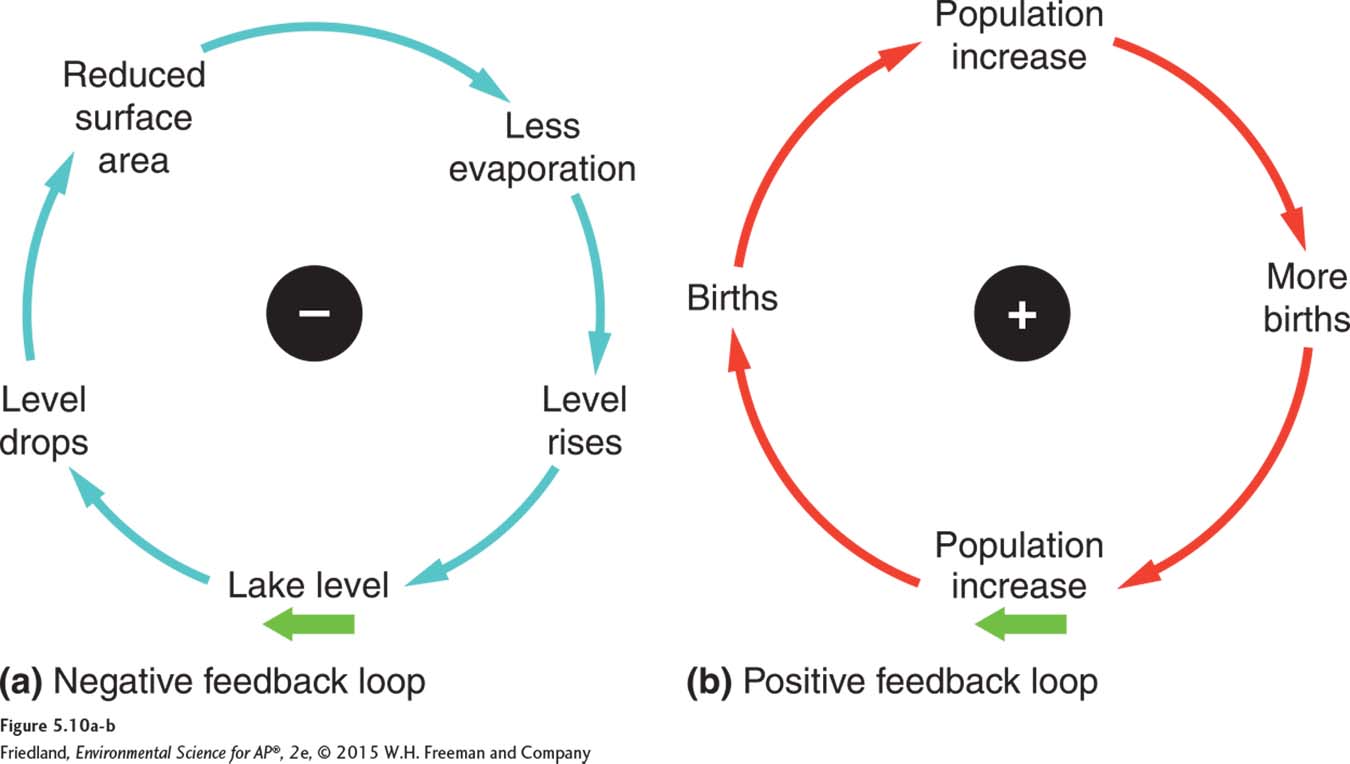
Positive feedback loop A feedback loop in which change in a system is amplified.
Positive feedbacks also occur in the natural world. FIGURE 5.10b shows an example of how births in a population can give rise to a positive feedback loop in which change in a system is amplified. The more members of a species that can reproduce, the more births there will be, creating even more of the species to give birth, and so on.
It’s important to note that positive and negative here do not mean good and bad; instead, positive feedback amplifies changes, whereas negative feedback resists changes. People often talk about the balance of nature. That balance is the logical result of systems reaching a state at which negative feedbacks predominate—
Environmental scientists are especially concerned with the extent to which Earth’s temperature is regulated by feedback loops. Understanding the role of feedback loops in temperature regulation, as well as the types of feedbacks and their scale, can help us make better predictions about climatic changes in the coming decades.
In general, warmer temperatures at Earth’s surface increase the evaporation of water. The additional water vapor that enters the atmosphere by evaporation causes two kinds of clouds to form. Low-
The health of many environmental systems depends on the proper operation of feedback loops. Sometimes, natural or anthropogenic factors lead to a breakdown in a negative feedback loop and drive an environmental system away from its steady state. As you study the exploitation of natural resources, try to determine what factors may be disrupting the negative feedback loops of the systems that provide those resources.
Change Across Space and over Time
Differences in environmental conditions affect what grows or lives in an area, which creates geographic variation among natural systems. Variations in temperature, precipitation, or soil composition across a landscape can lead to vastly different numbers and types of organisms. In Texas, for example, sycamore trees grow in river valleys where there is plenty of water available, whereas pine trees dominate mountain slopes because they can tolerate the cold, dry conditions there. Paying close attention to these natural variations may help us predict the effect of any change in an environment. We know that if the rivers that support the sycamores in Texas dry up, then the trees will probably die.

Natural systems are also affected by the passage of time. Thousands of years ago, when the climate of the Sahara was much wetter than it is today, it supported large populations of Nubian farmers and herders. Small changes in Earth’s orbit relative to the Sun, along with a series of other factors, led to the disappearance of monsoon rains in northern Africa. As a result of these changes, the Sahara—
Throughout Earth’s history, small natural changes have had large effects on complex systems, but human activities have increased both the pace and the intensity of these natural environmental changes, as they did at Mono Lake. Studying variations in natural systems over space and time can help scientists learn more about what to expect from the alterations humans are making to the world today.